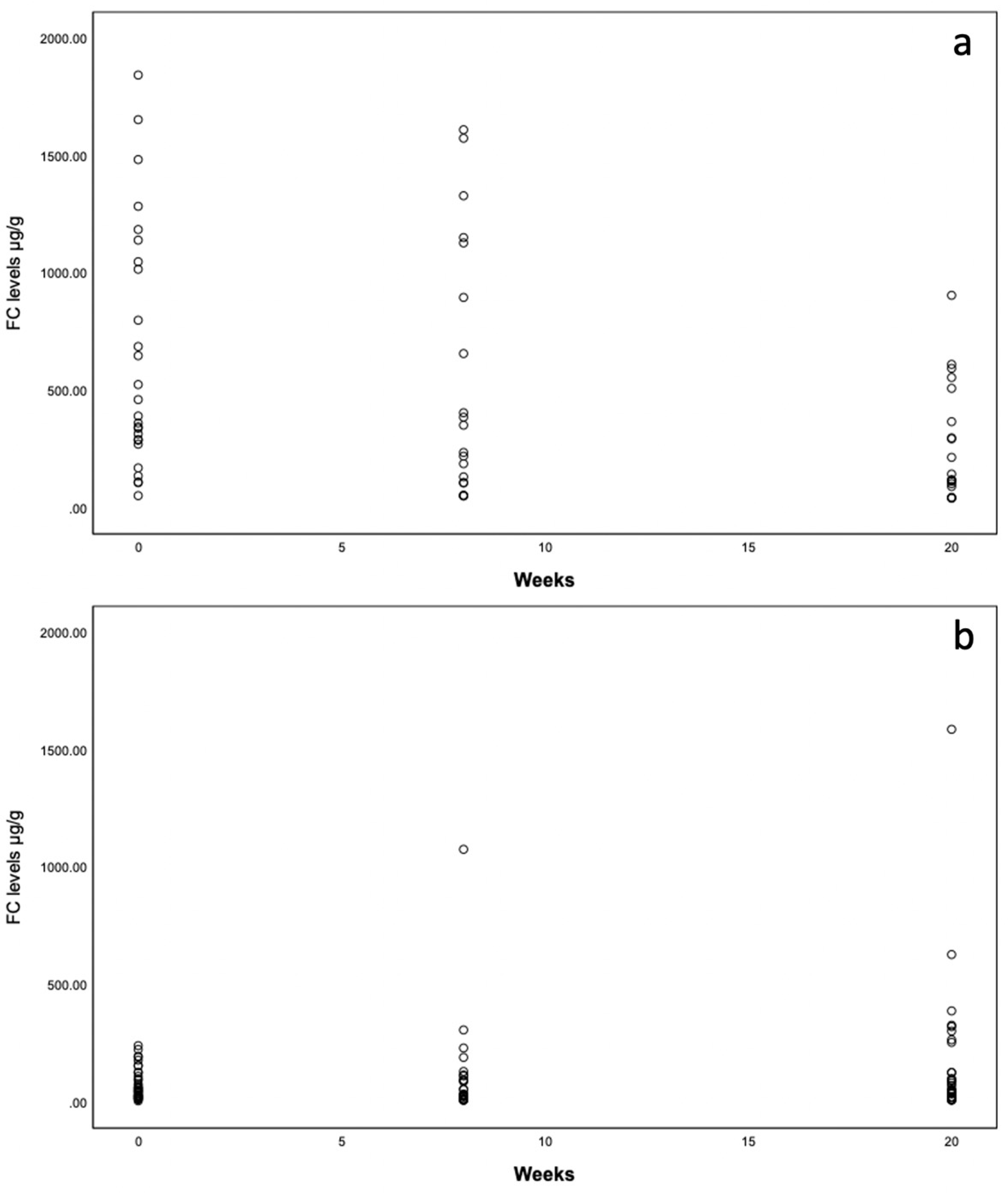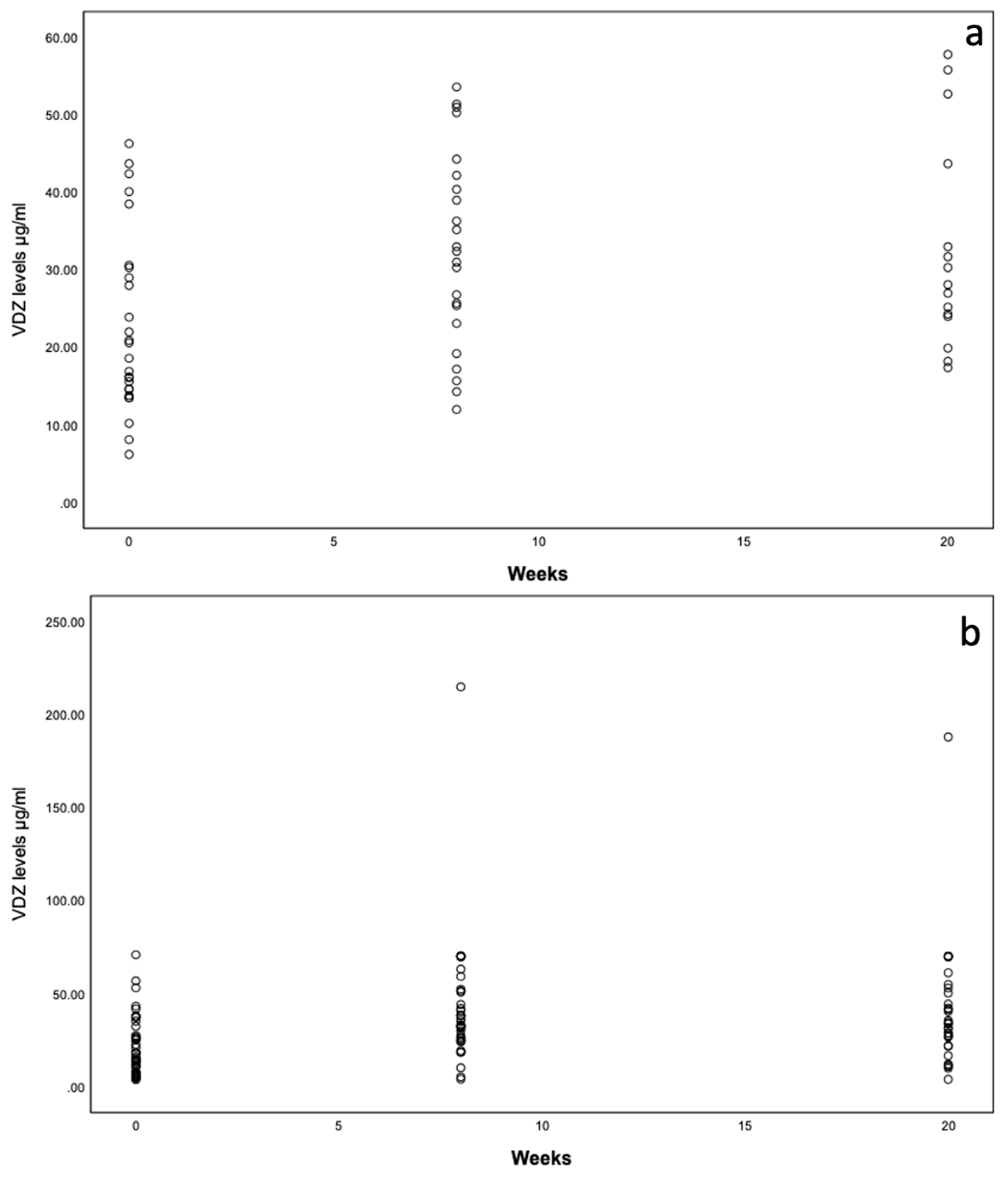Switching Vedolizumab from IV to SC Injection in Inflammatory Bowel Disease Patients with Active Disease: Real-World Experience from a German IBD Cohort
Abstract
:1. Introduction
2. Methods
2.1. Study Population
2.2. Study Design
2.3. Study Endpoints and Assessments
2.3.1. Efficacy
2.3.2. Safety/Adverse Events
2.3.3. Pharmacokinetics and Laboratory Testing
2.3.4. Statistical Analyses
2.4. Ethics Statement
3. Results
3.1. Study Population
3.1.1. Concomitant Oral Steroids
3.1.2. Previous Infusion Intervals or Recent Induction
3.2. Efficacy
3.2.1. Primary Endpoint: SC Persistence
3.2.2. Clinical Remission
3.2.3. Biochemical Remission
3.2.4. Biomarker Efficacy—FC Levels
3.2.5. Sub-Analysis for the Intensified (i.e., 4-Week) Interval Cohort: FC Level over Time in Relation to Disease Activity at the Switch
3.2.6. Sub-Analysis for C-Reactive Protein (CRP) Levels by Disease Activity
3.3. Pharmakokinetics—VDZ Trough Level
3.4. ROC Analysis to Determine the VDZ Serum Concentration Cut-off
3.5. Safety/Adverse Events
3.6. Missing Data Analysis
4. Discussion
Supplementary Materials
Author Contributions
Funding
Data Availability Statement
Conflicts of Interest
References
- Raine, T.; Bonovas, S.; Burisch, J.; Kucharzik, T.; Adamina, M.; Annese, V.; Bachmann, O.; Bettenworth, D.; Chaparro, M.; Czuber-Dochan, W.; et al. ECCO Guidelines on Therapeutics in Ulcerative Colitis: Medical Treatment. J. Crohn’s Colitis 2022, 16, 2–17. [Google Scholar] [CrossRef] [PubMed]
- Torres, J.; Bonovas, S.; Doherty, G.; Kucharzik, T.; Gisbert, J.P.; Raine, T.; Adamina, M.; Armuzzi, A.; Bachmann, O.; Bager, P.; et al. ECCO Guidelines on Therapeutics in Crohn’s Disease: Medical Treatment. J. Crohn’s Colitis 2020, 14, 4–22. [Google Scholar] [CrossRef] [PubMed]
- Turner, D.; Ricciuto, A.; Lewis, A.; D’amico, F.; Dhaliwal, J.; Griffiths, A.M.; Bettenworth, D.; Sandborn, W.J.; Sands, B.E.; Reinisch, W.; et al. STRIDE-II: An Update on the Selecting Therapeutic Targets in Inflammatory Bowel Disease (STRIDE) Initiative of the International Organization for the Study of IBD (IOIBD): Determining Therapeutic Goals for Treat-to-Target strategies in IBD. Gastroenterology 2021, 160, 1570–1583. [Google Scholar] [CrossRef] [PubMed]
- Feagan, B.G.; Rutgeerts, P.; Sands, B.E.; Hanauer, S.; Colombel, J.-F.; Sandborn, W.J.; Van Assche, G.; Axler, J.; Kim, H.-J.; Danese, S.; et al. Vedolizumab as induction and maintenance therapy for ulcerative colitis. N. Engl. J. Med. 2013, 369, 699–710. [Google Scholar] [CrossRef] [PubMed]
- Rosario, M.; Abhyankar, B.; Sankoh, S.; Dirks, N.; Lasch, K.; Sandborn, W. Relationship between vedolizumab pharmacokinetics and endoscopic outcomes in patients with ulcerative colitis. J. Crohn’s Colitis 2015, 9 (Suppl. S1), S46. [Google Scholar]
- Wyant, T.; Fedyk, E.; Abhyankar, B. An overview of the mechanism of action of the monoclonal antibody vedolizumab. J. Crohn’s Colitis 2016, 10, 1437–1444. [Google Scholar] [CrossRef] [PubMed]
- Sandborn, W.J.; Baert, F.; Danese, S.; Krznarić, Ž.; Kobayashi, T.; Yao, X.; Chen, J.; Rosario, M.; Bhatia, S.; Kisfalvi, K.; et al. Efficacy and Safety of Vedolizumab Subcutaneous Formulation in a Randomized Trial of Patients with Ulcerative Colitis. Gastroenterology 2020, 158, 562–572.e12. [Google Scholar] [CrossRef] [PubMed]
- Vermeire, S.; D’haens, G.; Baert, F.; Danese, S.; Kobayashi, T.; Loftus, E.V.; Bhatia, S.; Agboton, C.; Rosario, M.; Chen, C.; et al. Efficacy and Safety of Subcutaneous Vedolizumab in Patients with Moderately to Severely Active Crohn’s Disease: Results From the VISIBLE 2 Randomised Trial. J. Crohn’s Colitis 2022, 16, 27–38. [Google Scholar] [CrossRef] [PubMed]
- European Medicines Agency Entyvio. Entyvio (Vedolizumab) An overview of Entyvio and Why It Is Authorised in the EU. Available online: https://www.ema.europa.eu/en/documents/overview/entyvio-epar-summary-public_en.pdf (accessed on 1 June 2023).
- Ventress, E.; Young, D.; Rahmany, S.; Harris, C.; Bettey, M.; Smith, T.; Moyses, H.; Lech, M.; Gwiggner, M.; Felwick, R.; et al. Transitioning from intravenous to subcutaneous vedolizumab in patients with inflammatory bowel disease (TRAVELESS). J. Crohn’s Colitis 2021, 16, jjab224. [Google Scholar] [CrossRef] [PubMed]
- Harvey, R.F.; Bradshaw, J.M. A simple index of Crohn’s-disease activity. Lancet 1980, 1, 514. [Google Scholar] [CrossRef] [PubMed]
- IGIBD Scores calculator. Available online: https://www.igibdscores.it/en/info-mayo-partial.html (accessed on 1 June 2023).
- Bergqvist, V.; Holmgren, J.; Klintman, D.; Marsal, J. Real-world data on switching from intravenous to subcutaneous vedolizumab treatment in patients with inflammatory bowel disease. Aliment. Pharmacol. Ther. 2022, 55, 1389–1401. [Google Scholar] [CrossRef] [PubMed]
- Volkers, A.; Straatmijer, T.; Duijvestein, M.; Sales, A.; Levran, A.; van Schaik, F.; Maljaars, J.; Gecse, K.; Ponsioen, C.; Grootjans, J.; et al. Real-world experience of switching from intravenous to subcutaneous vedolizumab maintenance treatment for inflammatory bowel diseases. Aliment. Pharmacol. Ther. 2022, 56, 1044–1054. [Google Scholar] [CrossRef] [PubMed]
- Wiken, T.H.; Høivik, M.L.; Buer, L.; Warren, D.J.; Bolstad, N.; Moum, B.A.; Anisdahl, K.; Småstuen, M.C.; Medhus, A.W. Switching from intravenous to subcutaneous vedolizumab maintenance treatment in patients with inflammatory bowel disease followed by therapeutic drug monitoring. Scand. J. Gastroenterol. 2023, 58, 863–873. [Google Scholar] [CrossRef] [PubMed]
- Lim, S.H.; Gros, B.; Sharma, E.; Lehmann, A.; Lindsay, J.O.; Caulfield, L.; Gaya, D.R.; Taylor, J.; Limdi, J.; Kwok, J.; et al. Safety, Effectiveness, and Treatment Persistence of Subcutaneous Vedolizumab in IBD: A Multicenter Study from the United Kingdom. Inflamm. Bowel Dis. 2023. [Google Scholar] [CrossRef] [PubMed]



| Active Disease | Remission | |
|---|---|---|
| Age n, median (IQR) | n = 35, 40 (30) | n = 47, 38 (25) |
| Female gender n (%) | n = 35, 19 (54.3) | n = 47, 24 (51.1) |
| BMI n, median (IQR) | n = 33, 23.8 (7.8) | n = 47, 26.5 (7.7) |
| Prior biologicals n (%) | n = 33, 17 (51.5) | n = 46, 15 (32.6) |
| >1 Biologicals n (%) | n = 17, 9 (52.9) | n = 15, 6 (40) |
| Infusions prior to the switch n, median (IQR) | n = 35, 7 (20) | n = 47, 10 (13) |
| SC continued after week 20 n (%) | n = 29, 19 (65.5) | n = 44, 34 (77.3) |
| Crohn’s disease n (%) | n = 35, 12 (34.3) | n = 47, 14 (29.8) |
| Concomitant medications n (%) | n = 35, 18 (51.4) | n = 47, 24 (51.1) |
| 5-ASA oral | 7 | 14 |
| 5-ASA rectal | 1 | 3 |
| 5-ASA oral and rectal | 2 | 2 |
| Sulfasalazine | 0 | 2 |
| Oral steroids at switch | 8 | 3 |
| Active Disease n = 35 | Remission n = 47 | |
|---|---|---|
| Induction, n (%) | 14 (40.0) | 6 (12.7) |
| 8-week interval, n (%) | 14 (40.0) | 31 (66.0) |
| 4-week interval, n (%) | 7 (20.0) | 10 (21.3) |
| Active Disease n = 35 | Remission n = 47 | |
|---|---|---|
| Clinical remission | ||
| Switch, n (%) | n = 33, 10 (30.3) | n = 45, 45 (100) |
| Week 8, n (%) | n = 29, 15 (51.7) | n = 40, 39 (97.5) |
| Week 20, n (%) | n = 18, 12 (66.7) | n = 38, 37 (97.4) |
| Biochemical remission | ||
| Switch, n (%) | n = 28, 5 (17.9) | n = 32, 32 (100) |
| Week 8, n (%) | n = 19, 9 (47.4) | n = 26, 23 (88.5) |
| Week 20, n (%) | n = 17, 9 (52.9) | n = 32, 24 (75) |
| FC Level | Active Disease | Remission |
|---|---|---|
| Switch n, median (IQR) | n = 26, 426 (787.3) | n = 32 58 (99.5) |
| Week 8 n, median (IQR) | n = 19, 352 (1020) | n = 24, 43 (98) |
| Week 20 n, median (IQR) | n = 18, 179.5 (420.5) | n = 33, 49 (168.5) |
| FC Level | Active Disease | Remission |
|---|---|---|
| Switch n, median (IQR) | n = 4, 406.5 (711) | n = 6, 44 (49.8) |
| Week 8 n, median (IQR) | n = 4, 81 (265) | n = 3, (94) |
| Week 20 n, median (IQR) | n = 4, 166 (392.8) | n = 6, 46.2 (253.3) |
| VDZ Trough Level | Entire Cohort | Active Disease | Remission |
|---|---|---|---|
| Switch n, median (IQR) | n = 69, 16.9 (18.7) | n = 26, 19.6 (16) | n = 43, 14.9 (20) |
| Week 8 n, median (IQR) | n = 61, 33 (22.15) | n = 23, 32.4 (19.1) | n = 38, 34.25 (26.15) |
| Week 20 n, median (IQR) | n = 48, 31.7 (28.05) | n = 15, 28.1 (19.7) | n = 33, 33.9 (29.5) |
Disclaimer/Publisher’s Note: The statements, opinions and data contained in all publications are solely those of the individual author(s) and contributor(s) and not of MDPI and/or the editor(s). MDPI and/or the editor(s) disclaim responsibility for any injury to people or property resulting from any ideas, methods, instructions or products referred to in the content. |
© 2023 by the authors. Licensee MDPI, Basel, Switzerland. This article is an open access article distributed under the terms and conditions of the Creative Commons Attribution (CC BY) license (https://creativecommons.org/licenses/by/4.0/).
Share and Cite
Kubesch, A.; Kruse, N.; Jungheim, F.; Balaban, Ü.; Stratmann, K.; Sprinzl, K.; Dienethal, A.; Krause, T.; Zeuzem, S.; Blumenstein, I. Switching Vedolizumab from IV to SC Injection in Inflammatory Bowel Disease Patients with Active Disease: Real-World Experience from a German IBD Cohort. J. Clin. Med. 2023, 12, 7657. https://doi.org/10.3390/jcm12247657
Kubesch A, Kruse N, Jungheim F, Balaban Ü, Stratmann K, Sprinzl K, Dienethal A, Krause T, Zeuzem S, Blumenstein I. Switching Vedolizumab from IV to SC Injection in Inflammatory Bowel Disease Patients with Active Disease: Real-World Experience from a German IBD Cohort. Journal of Clinical Medicine. 2023; 12(24):7657. https://doi.org/10.3390/jcm12247657
Chicago/Turabian StyleKubesch, Alica, Nina Kruse, Florian Jungheim, Ümniye Balaban, Katharina Stratmann, Kathrin Sprinzl, Antje Dienethal, Thomas Krause, Stefan Zeuzem, and Irina Blumenstein. 2023. "Switching Vedolizumab from IV to SC Injection in Inflammatory Bowel Disease Patients with Active Disease: Real-World Experience from a German IBD Cohort" Journal of Clinical Medicine 12, no. 24: 7657. https://doi.org/10.3390/jcm12247657
APA StyleKubesch, A., Kruse, N., Jungheim, F., Balaban, Ü., Stratmann, K., Sprinzl, K., Dienethal, A., Krause, T., Zeuzem, S., & Blumenstein, I. (2023). Switching Vedolizumab from IV to SC Injection in Inflammatory Bowel Disease Patients with Active Disease: Real-World Experience from a German IBD Cohort. Journal of Clinical Medicine, 12(24), 7657. https://doi.org/10.3390/jcm12247657






